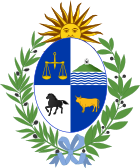1917 Uruguayan constitutional referendum
 |
|---|
|
A constitutional referendum was held in Uruguay on 25 November 1917.[1] Amongst the changes to the system of government, the new constitution would create a National Council of Administration (known as the colegiado) alongside the presidency.[2] The National Council of Administration would have nine members; six from the winning party and three from the runner-up party. The proposals were approved by 95.15% of voters.[3] The result was confirmed by the Senate on 18 December, and the new constitution came into force on 1 March 1919.[3]
Background[]
The colegiado system had been first proposed by President José Batlle y Ordóñez in 1913, with the aim of creating an executive body similar to the Swiss Federal Council.[2] Batlle had been opposed to the presidential system, believing that a collegiate body would lower the risk of a dictatorship emerging.[2] Although the proposal was defeated in 1916, Batlle negotiated a compromise with the National Party to include the system in a new constitution.[2]
New constitution[]
As well as introducing the colegiado system, the new constitution determined that presidents could only serve a single term in office.[3] It provided for a bicameral General Assembly with a term of four years, and introduced universal male suffrage.[3] It also provided for the separation of church and state and allowed for constitutional amendments to be made with a two-thirds majority in both chambers of the General Assembly.[3]
Results[]
| Choice | Votes | % |
|---|---|---|
| For | 84,992 | 95.15 |
| Against | 4,330 | 4.85 |
| Invalid/blank votes | – | |
| Total | 89,322 | 100 |
| Registered voters/turnout | 233'850 | 38.20 |
| Source: Direct Democracy | ||
See also[]
- Uruguayan Constitution
References[]
- ^ Nohlen, D (2005) Elections in the Americas: A data handbook, Volume II, p494 ISBN 978-0-19-928358-3
- ^ a b c d The Constitution Library of Congress Country Studies
- ^ a b c d e Uruguay, 25 November 1917: Constitution Direct Democracy (in German)
- 1917 referendums
- 1917 in Uruguay
- Referendums in Uruguay
- Constitutional referendums in Uruguay
- November 1917 events